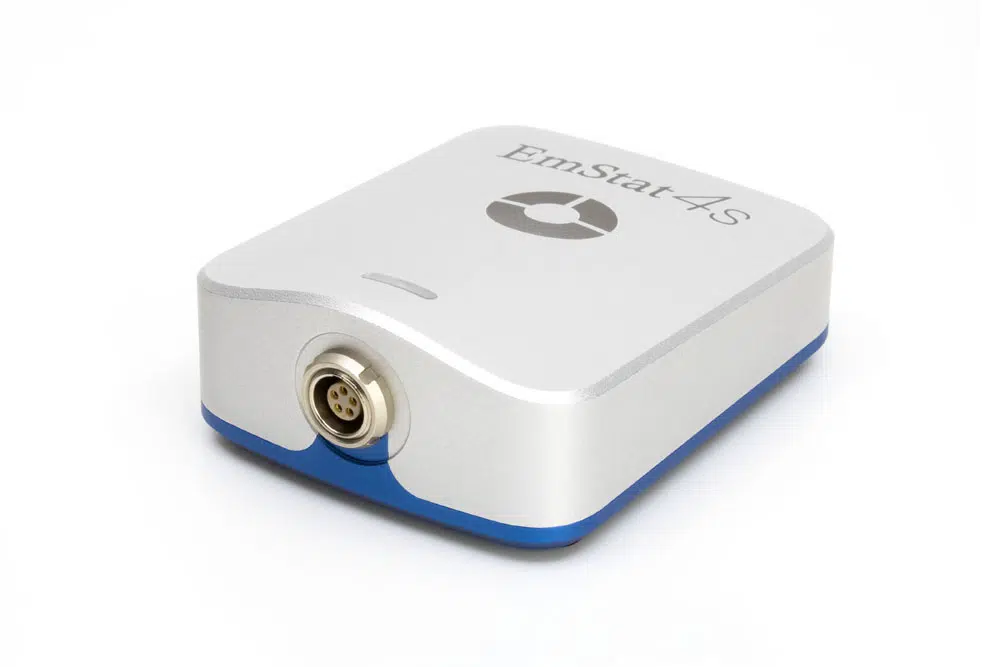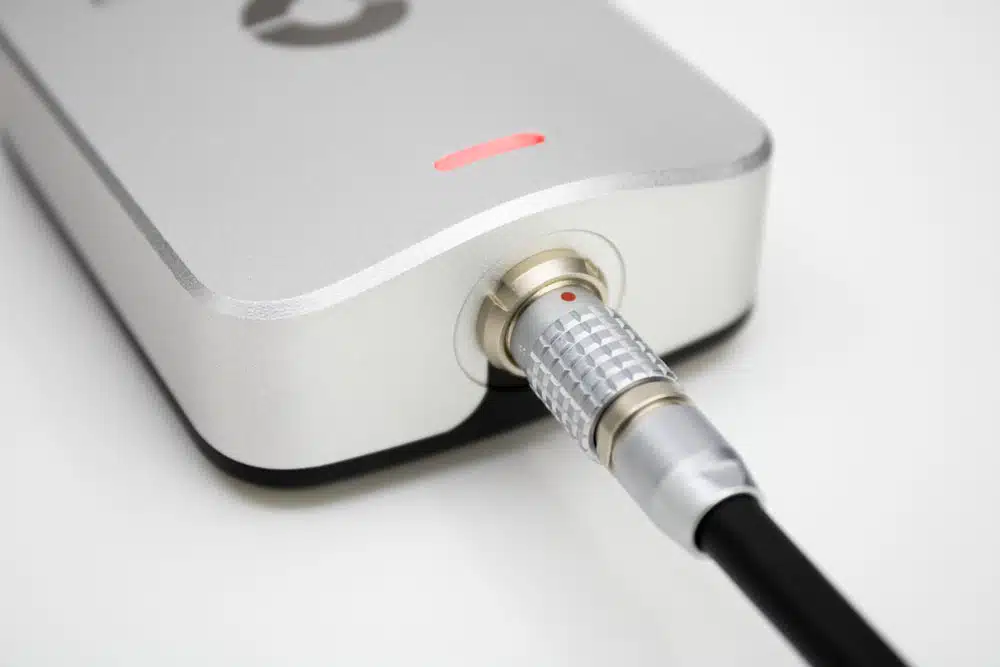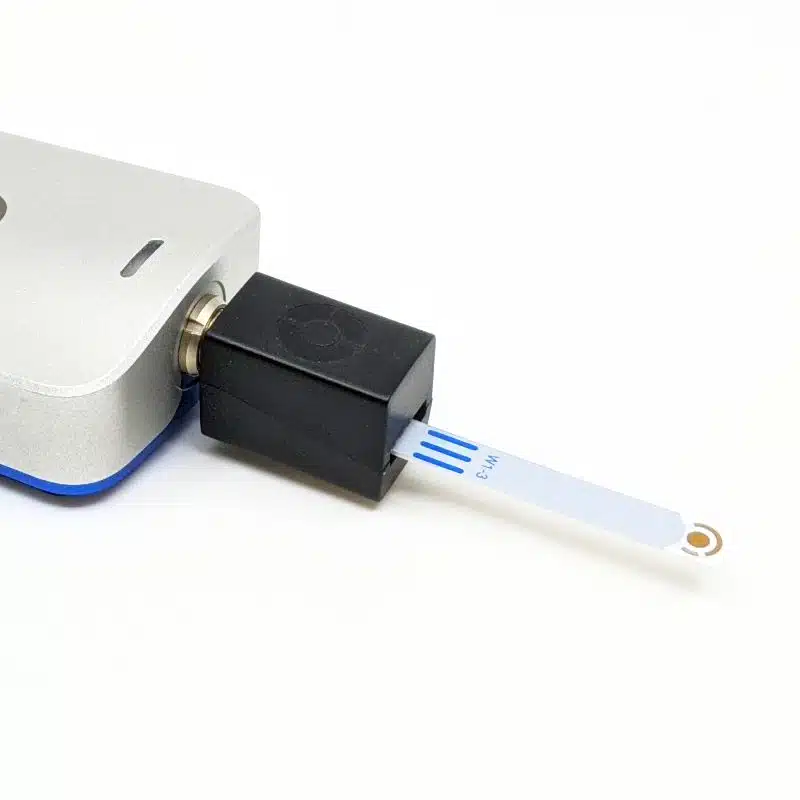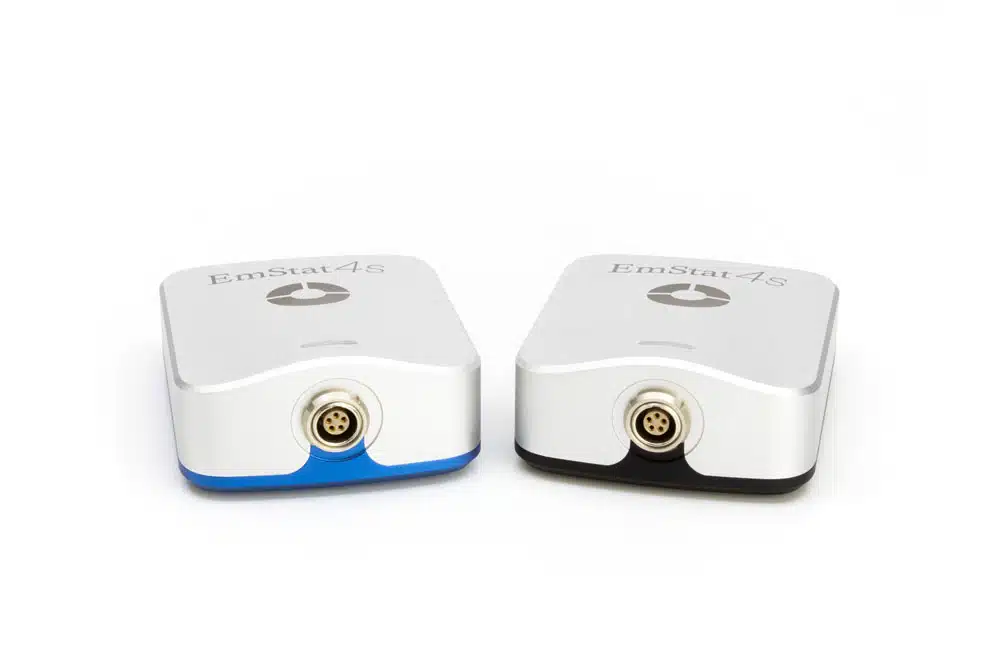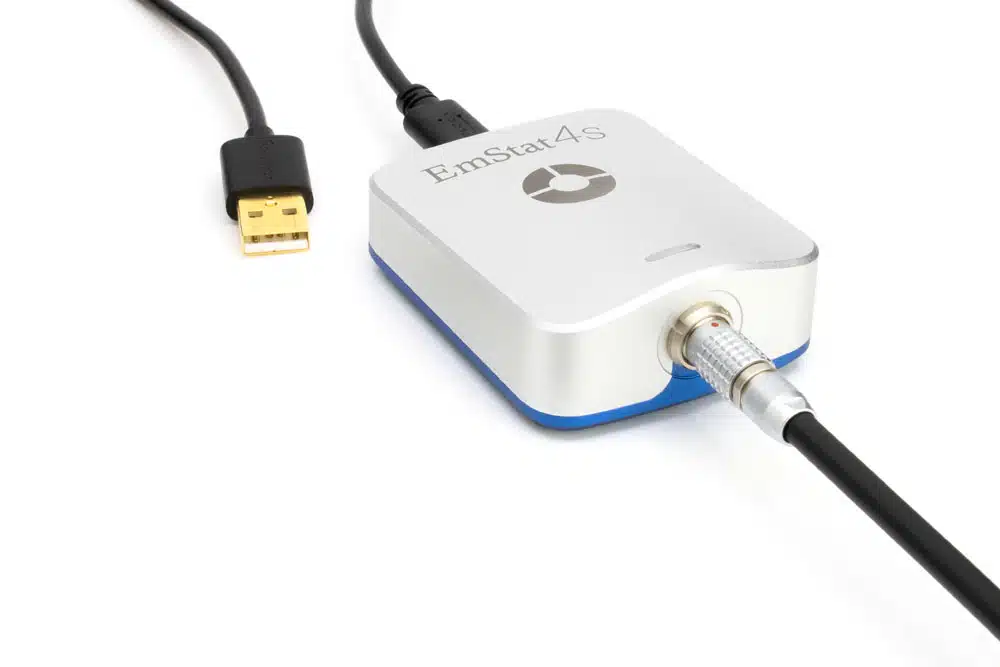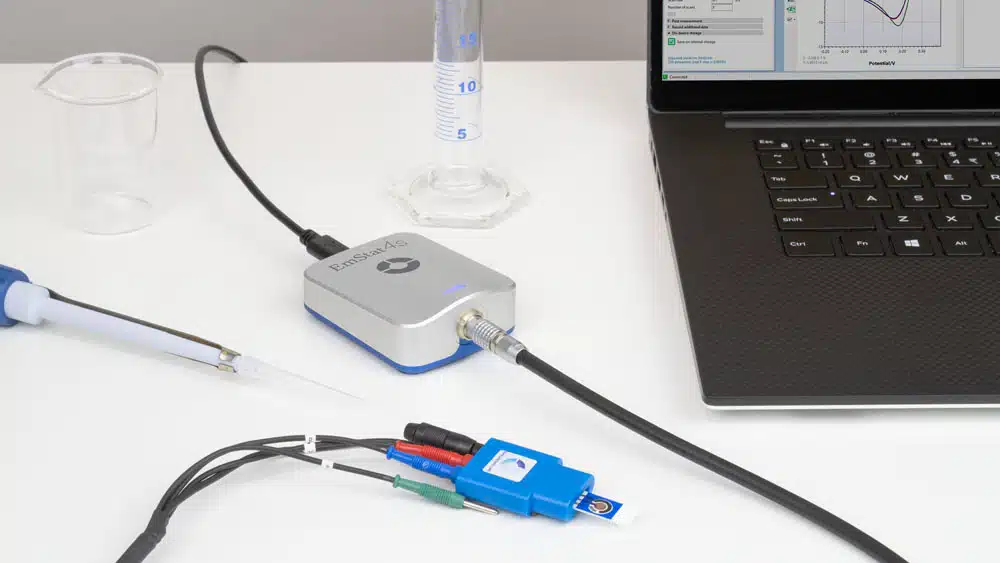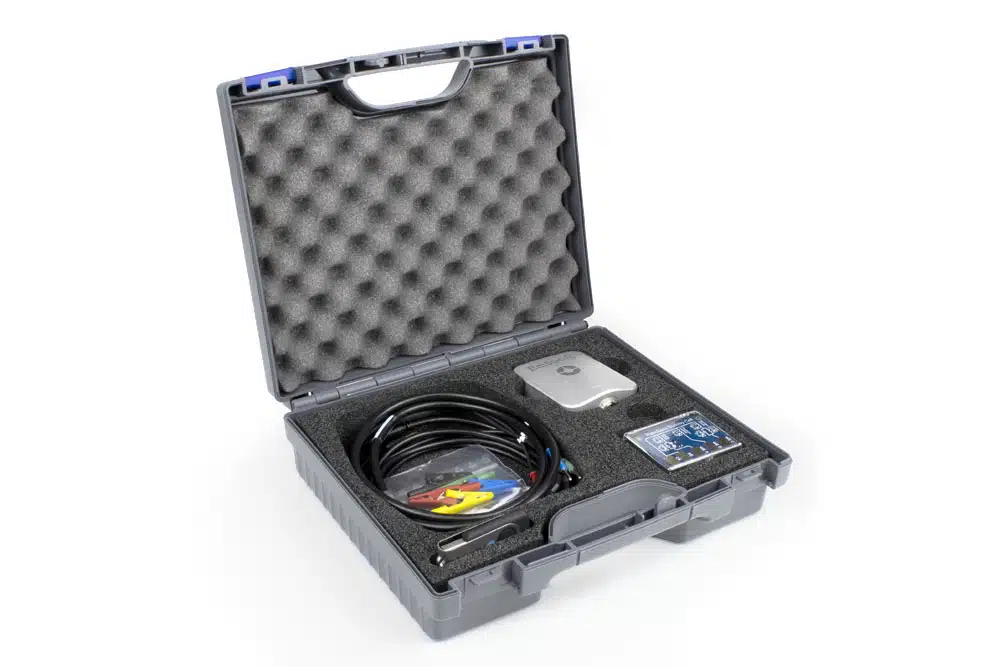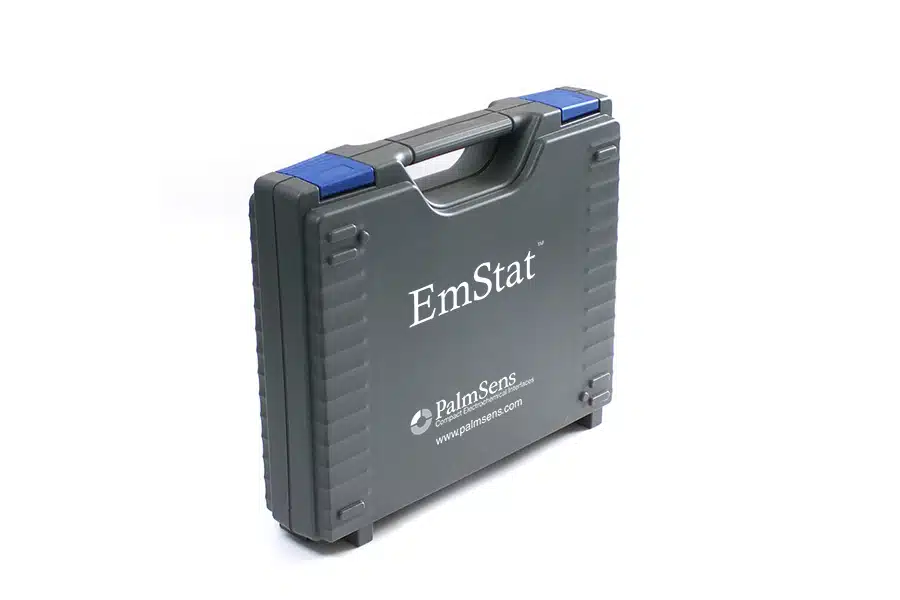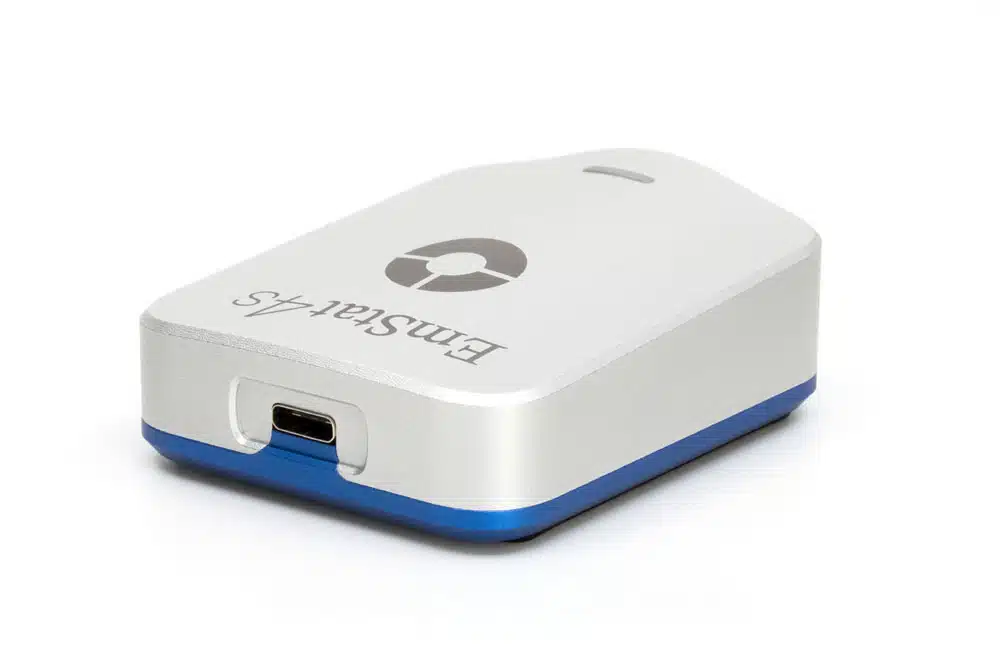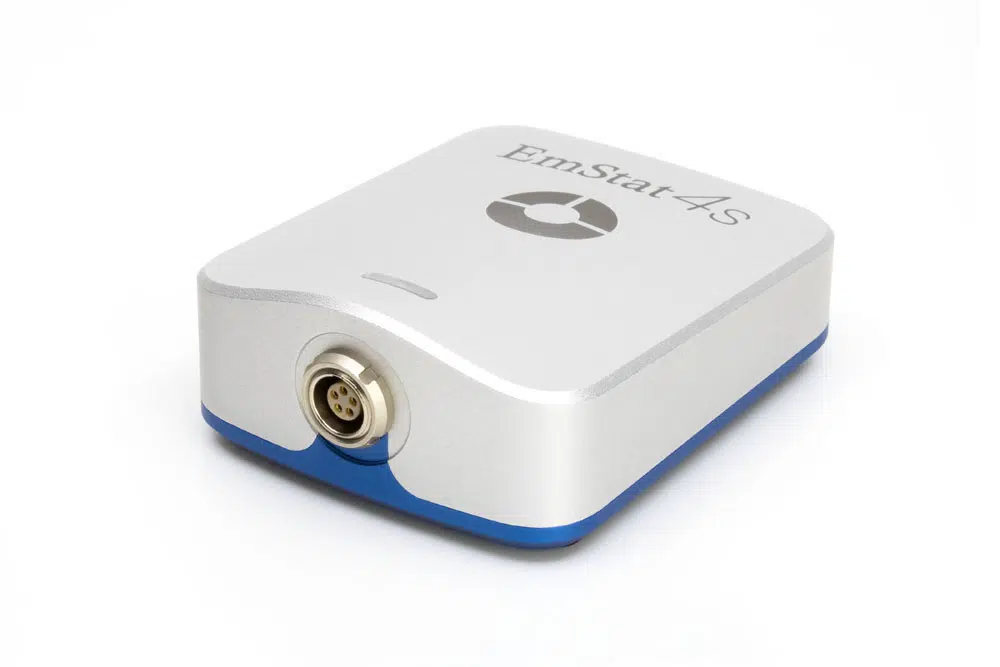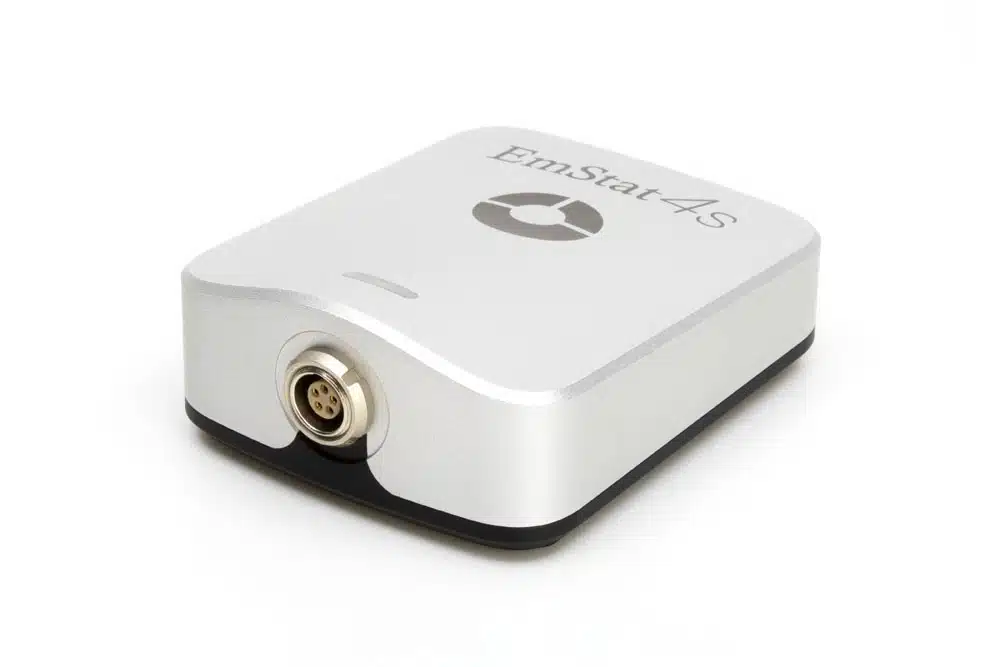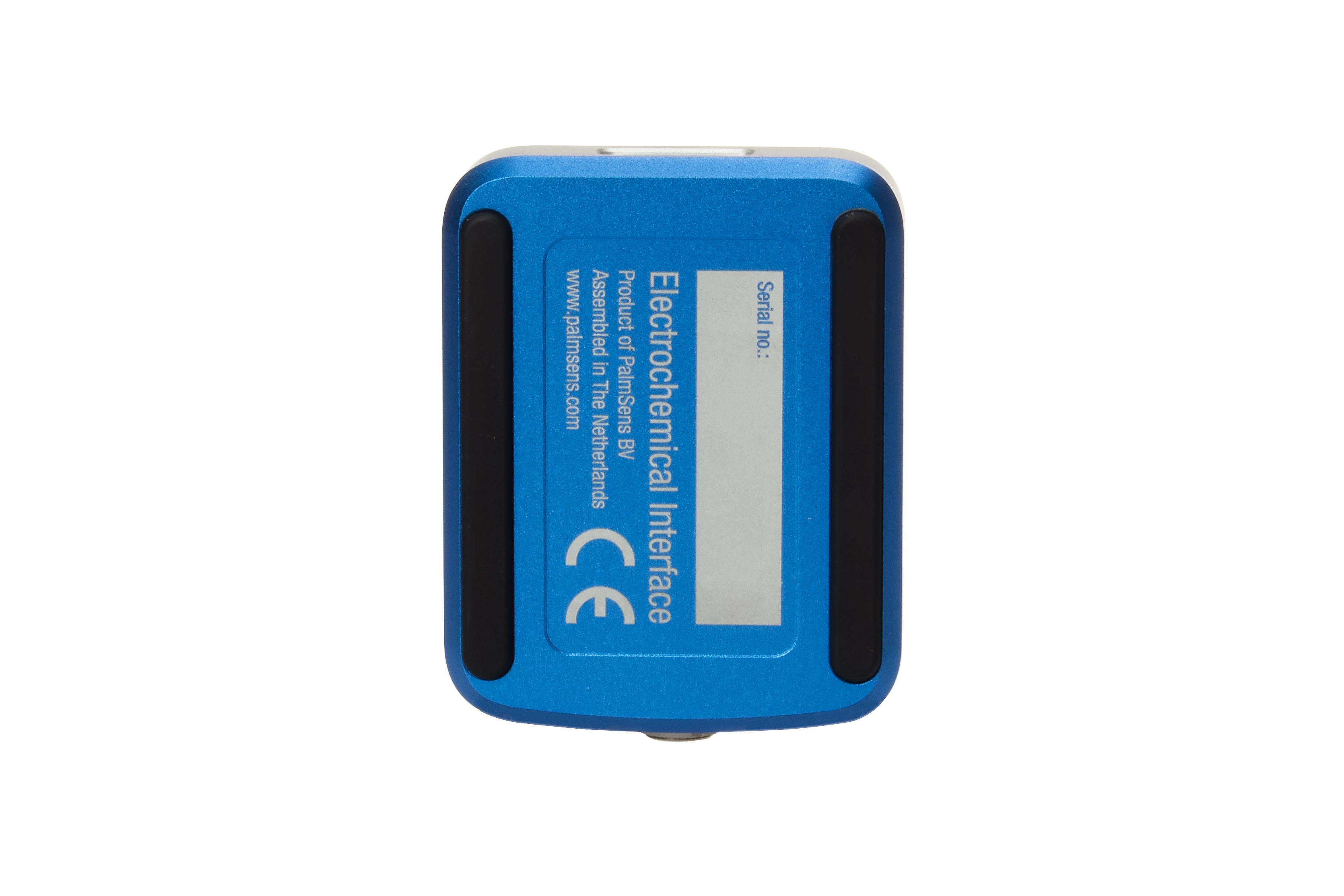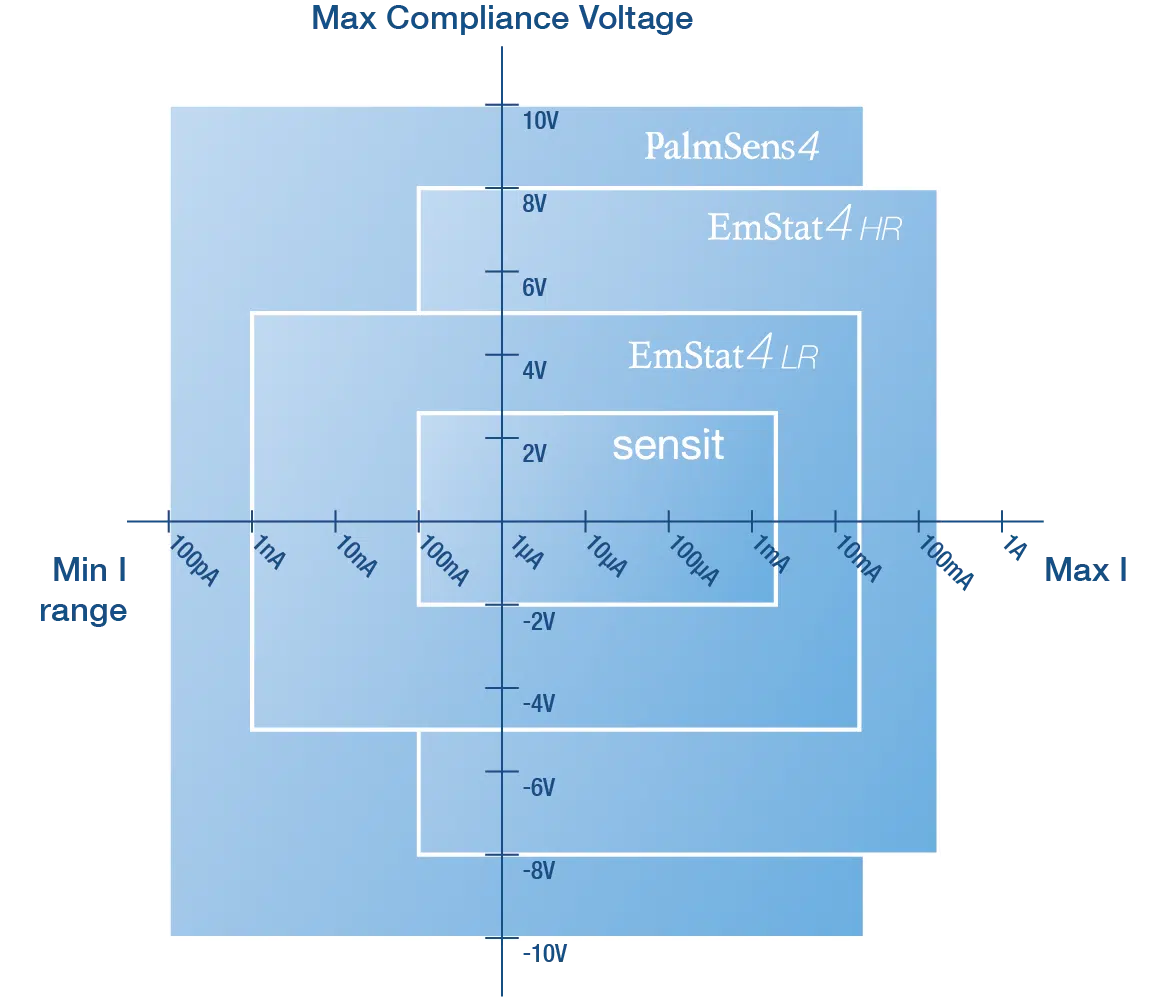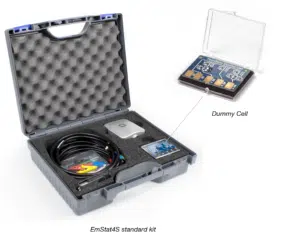EmStat4S
USB powered potentiostat / galvanostat with EIS
- Two versions: Low Range and High Range
- Potential range ±3 V or ±6 V
- Max. current ±30 mA or ±200 mA
- FRA / EIS: 10 µHz up to 200 kHz
Description
The EmStat4S delivers desktop performance in the palm of your hand. The EmStat4S is a portable USB-powered Potentiostat, Galvanostat, and optional a Frequency Response Analyser (FRA) for Electrochemical Impedance Spectroscopy (EIS). The EmStat4S is controlled with PSTrace for Windows, or you can write your own MethodSCRIPT and control it from any platform or operating system.
Versions
The EmStat4S comes in two different versions:
- Low Range: for lower currents and potentials
- High Range: for higher currents and potentials
Both versions can be configured with optional EIS/FRA with a maximum frequency of 200 kHz.
See specifications for a detailed comparison between the LR and HR.
Always a backup
Always a backup
The EmStat4S is equipped with 500 MB internal storage memory for storing your measurements as a backup. All internally stored measurements can be browsed and transferred back to the PC easily using the PSTrace software for Windows. Your data is always with your instrument wherever you take it.Standard included
A standard EmStat4S includes a rugged carrying case with:
- EmStat4S
- USB-C cable
- Sensor cable: high quality, double-shielded cable with 2 mm banana connectors for Working, Counter, Reference electrode and Ground
- 4 or 5 crocodile clips
- Dummy Cell
- PSTrace software for Windows (on USB drive)
- Manual (hardcopy)
- Quick Start document
- Calibration report
Specifications
The EmStat4S is available in two versions: the LR (Low Range) and HR (High Range) version.
| Main differences between the EmStat4S Low and High Range | ||
|---|---|---|
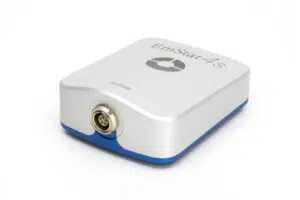 |
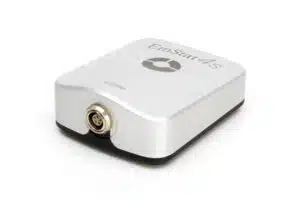 |
|
| EMSTAT4S LR™ | EMSTAT4S HR™ | |
| Potential range | ±3 V | ±6 V |
| Max. compliance voltage
The compliance voltage is the maximum voltage that can be applied between the working and counter electrode. Another name could be the maximum cell potential. Continue reading
|
±5 V | ±8 V |
Current ranges
A current range defines the maximum current a potentiostat can measure in a certain range. Continue reading
|
1 nA to 10 mA (8 ranges) | 100 nA to 100 mA (7 ranges) |
| Max. current | ±30 mA | ±200 mA |
| Electrode connections | WE, RE, CE and ground, 2 mm banana plugs |
WE, RE, CE, Sense, and ground, 2 mm banana plugs |
| General | ||
|---|---|---|
| LR | HR | |
dc-potential range
The maximum potential difference, that can be applied between WE and RE.
|
±3 V | ±6 V |
compliance voltage
The compliance voltage is the maximum voltage that can be applied between the working and counter electrode. Another name could be the maximum cell potential. Continue reading
|
±5 V | ±8 V |
| maximum current | ±30 mA | ±200 mA |
max. data acquisition rate
Also known as Sampling Rate, it describes how fast the instrument can collect measurement values. Continue reading
|
1 000 000 samples /s | |
| Potentiostat | ||
|---|---|---|
| LR | HR | |
| applied potential resolution | 100 µV | 183 µV |
applied potential accuracy
The applied potential accuracy describes how close to the real values your applied potential is.
|
≤ 0.2% ±1 mV offset | |
current ranges
A current range defines the maximum current a potentiostat can measure in a certain range. Continue reading
|
1 nA to 10 mA 8 ranges |
100 nA to 100 mA 7 ranges |
measured current resolution
The lowest observable difference between two values that a measurement device can differentiate between. Continue reading
|
0.009% of CR (92 fA on 1 nA range)
CR is the acronym we use for Current Range. A current range defines the maximum current a potentiostat can measure in a certain range. Continue reading
|
0.009% of CR (9.2 pA on 100 nA range)
CR is the acronym we use for Current Range. A current range defines the maximum current a potentiostat can measure in a certain range. Continue reading
|
| measured current accuracy
The current accuracy describes how close to the real values your measured current is. Continue reading
|
< 0.2% of current ±20 pA ±0.2% of range |
< 0.2% of current ±0.2% of range |
| Galvanostat | ||
|---|---|---|
| LR | HR | |
current ranges
A current range defines the maximum current a potentiostat can measure in a certain range. Continue reading
|
10 nA, 1 uA, 100 uA, 10 mA 4 ranges |
1 uA, 100 uA, 10 mA, 100 mA 4 ranges |
| applied dc-current | ±3 * CR (current range)
CR is the acronym we use for Current Range. A current range defines the maximum current a potentiostat can measure in a certain range. Continue reading
|
|
| applied dc-current resolution | 0.01% of CR | 0.0183% of CR |
| applied dc- current accuracy
The current accuracy describes how close to the real values your measured current is. Continue reading
|
< 0.4% of current ±20 pA ±0.2% of range |
< 0.4% of current ±0.2% of range |
| potential ranges |
50 mV, 100 mV, 200 mV, 500 mV, 1 V |
|
| measured dc-potential resolution |
96 µV at ±3 V (1 V range) |
193 µV at ±6 V (1 V range) |
| measured dc-potential accuracy | ≤ 0.2% potential ±1 mV offset | |
| FRA / EIS | ||
|---|---|---|
| LR | HR | |
| frequency range | 10 µHz to 200 kHz | |
| ac-amplitude range |
1 mV to 900 mV rms, or 2.5 V p-p |
|
| measured current accuracy
The current accuracy describes how close to the real values your measured current is. Continue reading
|
≤ 0.2% at Full Scale Range | |
| GEIS | ||
|---|---|---|
| LR | HR | |
| frequency range | 10 µHz to 100 kHz | |
| ac-amplitude range |
0.9 * CR (Arms)
CR is the acronym we use for Current Range. A current range defines the maximum current a potentiostat can measure in a certain range. Continue reading
|
|
| Electrometer | ||
|---|---|---|
| LR | HR | |
electrometer amplifier input
The amplifier input resistance of the amplifier in the electrometer determines the load that the amplifier places on the source of the signal being fed into it. Ideally the resistance is infinite, and the load to be zero to not to influence your measurement.
|
> 1 TΩ // 10 pF | |
bandwidth
Bandwidth defines the range of frequencies a system can accurately measure or respond to. Continue reading
|
500 kHz |
|
| Other | ||
|---|---|---|
| LR | HR | |
| electrode connections |
WE, RE, CE, |
WE, RE, CE, S |
| housing |
aluminum body: |
|
| weight |
± 130 g |
|
| power + communication |
USB-C port |
|
| internal storage space |
500 MB, equivalent to > 15M datapoints |
|
| EmStat4S LR EIS Accuracy Contour Plot |
|---|
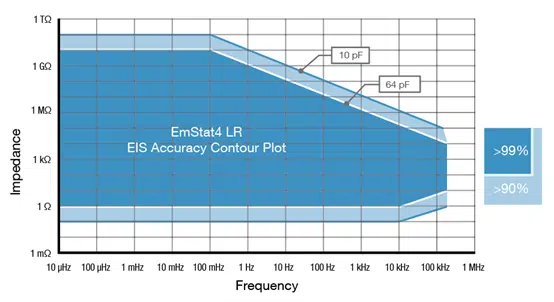 |
| EmStat4S HR EIS Accuracy Contour Plot |
|---|
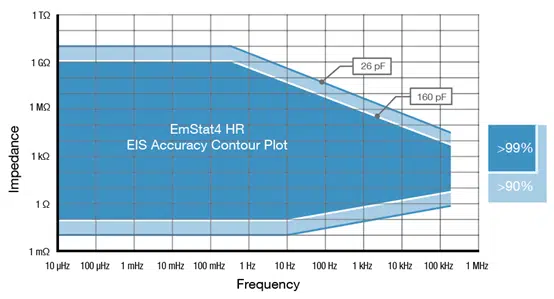 |
Software
PSTrace
PSTrace is designed to be productive immediately after installation, without going through a long learning period. It has three modes; the Scientific mode which allows you to run all the techniques our instruments have to offer, and two dedicated modes for Corrosion analysis and the Analytical Mode. PSTrace is suitable for all levels of user experience.
Features include:
- Direct validation of method parameters
- Automated peak search
- Equivalent Circuit Fitting
- Scripting for running an automated sequence of measurements
- Open data in Origin and Excel with one click of a button
- Load data from the instrument’s internal storage
- and many more…
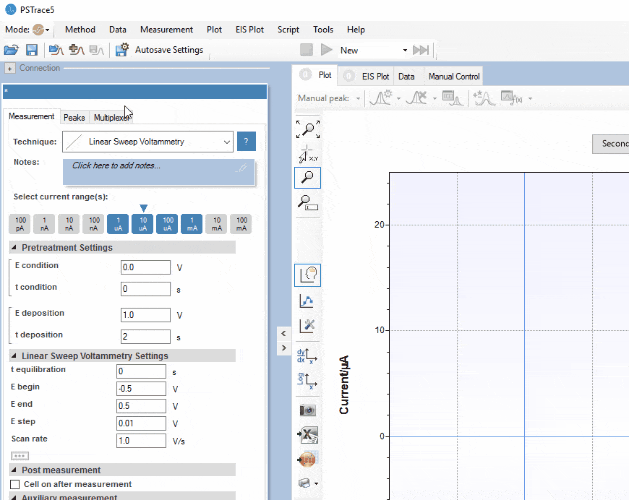
PStouch
PStouch is an app for Android devices compatible with all PalmSens, EmStat and Sensit potentiostats. The app connects to your potentiostat via USB (depending on the Android device) or via Bluetooth.
PStouch features include:
- Setting up and running measurements
- All files compatible with PSTrace
- Analysing and manipulating peaks
- Sharing data directly via e-mail, Dropbox, or any other file sharing service
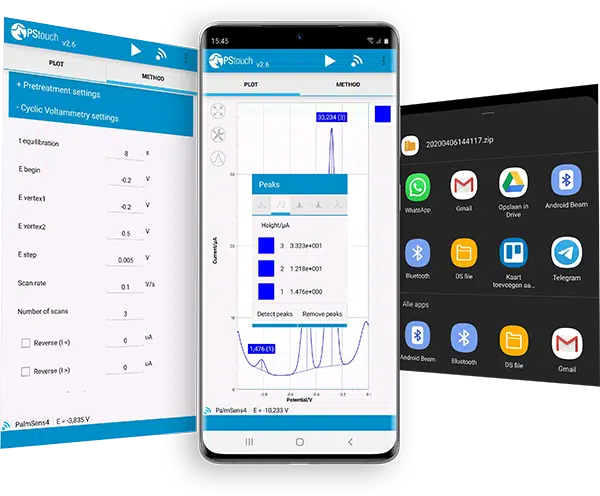
Software Development Kits
PalmSens provides several Software Development Kits (SDKs) to help developers create custom software to control their potentiostat. Each SDK comes with documentation and examples that shows how to use the libraries.
SDKs are available for:
- .NET (WinForms, WPF and Xamarin for Android)
- Python
- LabVIEW
- Matlab

MethodSCRIPT™ Communications Protocol
The EmStat4-series instruments work with MethodSCRIPT™, giving you full control over your potentiostat. The simple script language is parsed on-board, which means no DLLs or other type of code libraries are required. MethodSCRIPT™ allows for running all supported electrochemical techniques, making it easy to combine different measurements and other tasks.
MethodSCRIPT can be generated, edited, and executed in PSTrace.
MethodSCRIPT features includes:
- (Nested) loops and conditional logic support
- User code during a measurement iteration
- Exact timing control
- Simple math operations on variables (add, sub, mul, div)
- Data smoothing and peak detection
- Digital I/O, for example for waiting for an external trigger
- Logging results to internal storage or external SD card
- Reading auxiliary values like pH or temperature
- and many more…

Downloads
Documentation (6)
| Name | Last updated | |
|---|---|---|
| EmStat4S Brochure The EmStat4S brochure contains an overview of all the supported techniques, specifications, software, EIS accuracy contour plots, kit contents, and more. | 22-01-25 | |
| MethodSCRIPT v1.5 The MethodSCRIPT scripting language is designed to improve the flexibility of the PalmSens potentiostat and galvanostat devices for OEM users. It allows users to start measurements with arguments that are similar to the arguments in PSTrace. PalmSens provides libraries and examples for handling low level communication and generating scripts for MethodSCRIPT devices such as the EmStat Pico and EmStat4. | 25-03-24 | |
| EmStat4M Communication Protocol V1.3 Describes how to communicate with the EmStat4M directly and how to send MethodSCRIPTS. | 25-03-24 | |
| EmStat4S Operator’s Manual Learn how to connect the instrument, understand the specifications, use the features and troubleshoot if needed. | 13-03-24 | |
| EmStat4M Communication Protocol V1.2 Describes how to communicate with the EmStat4M directly and how to send MethodSCRIPTS. | 01-02-23 | |
| MethodSCRIPT v1.4 The MethodSCRIPT scripting language is designed to improve the flexibility of the PalmSens potentiostat and galvanostat devices for OEM users. It allows users to start measurements with arguments that are similar to the arguments in PSTrace. PalmSens provides libraries and examples for handling low level communication and generating scripts for MethodSCRIPT devices such as the EmStat Pico and EmStat4. | 01-02-23 |
Software (1)
| Name | Last updated | |
|---|---|---|
| PSTrace PC software for all single channel instruments PSTrace software is shipped as standard with all single channel and multiplexed instruments. The software provides support for all techniques and device functionalities. | 08-07-24 |





























